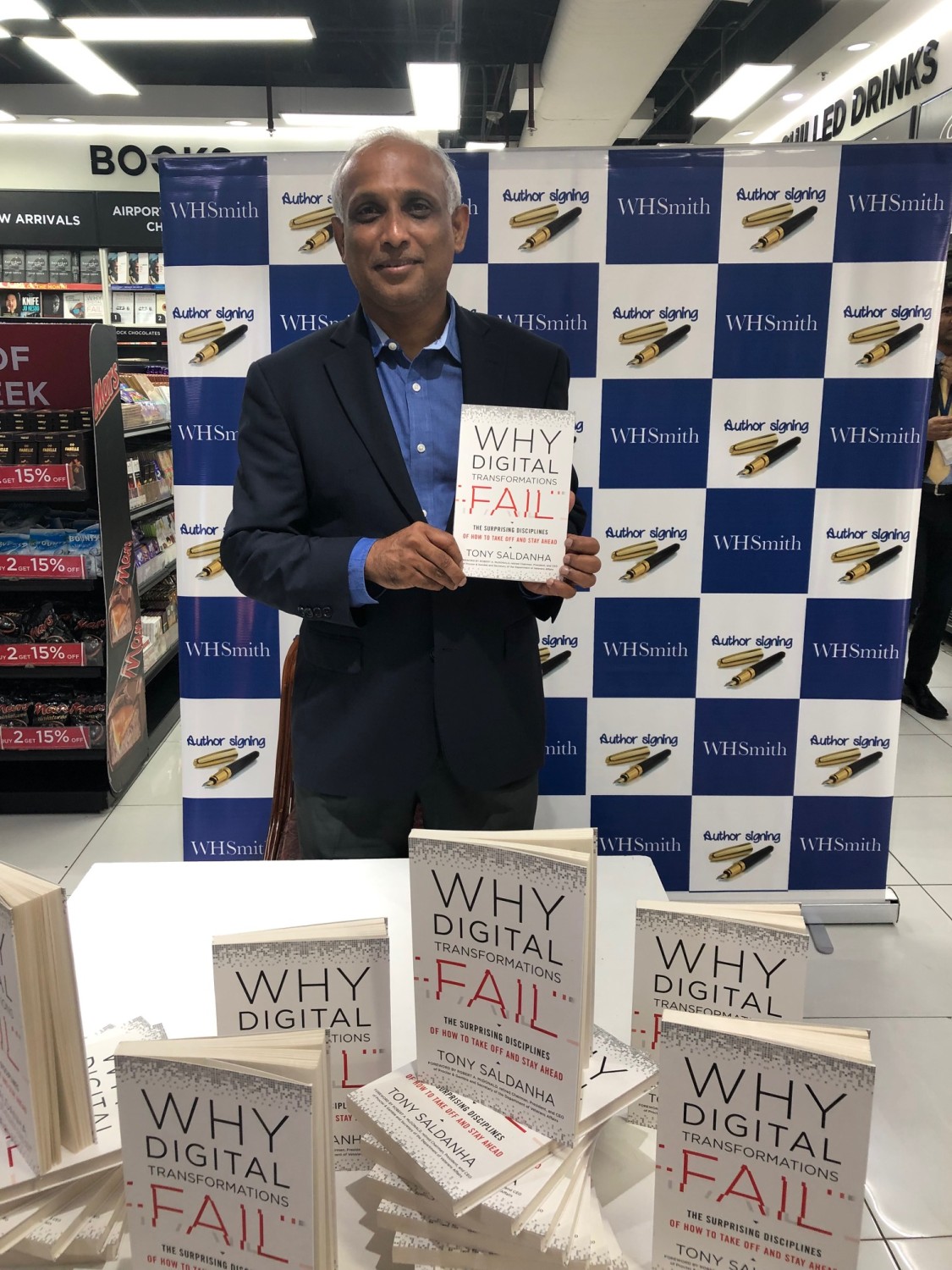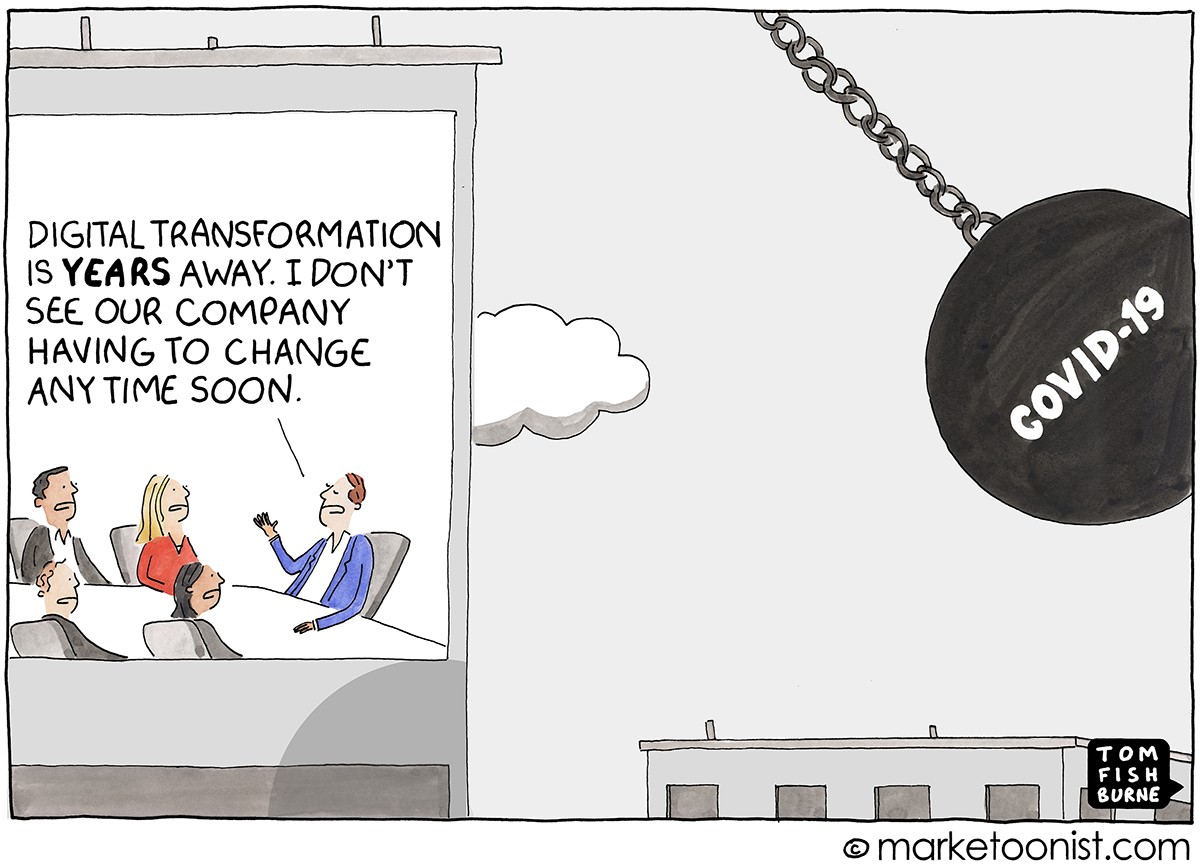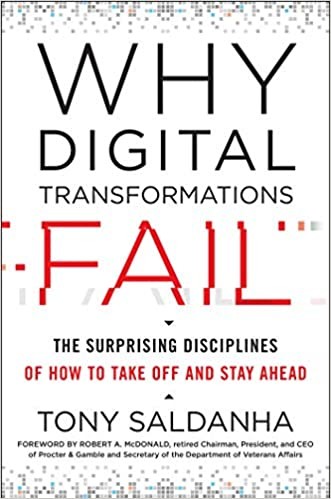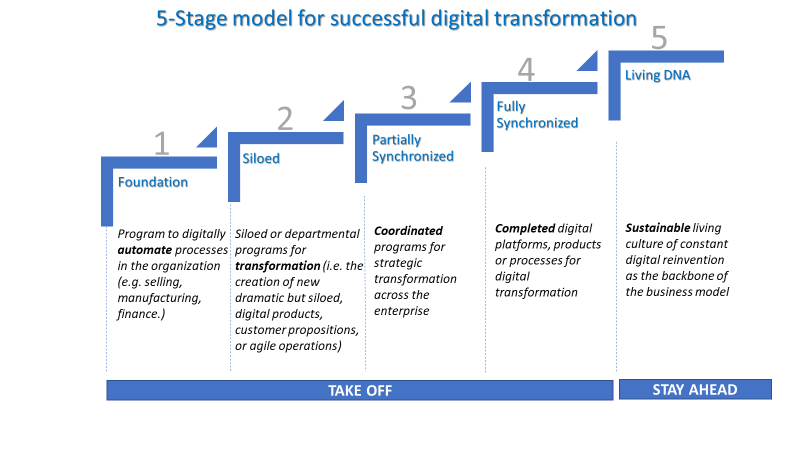Tony Saldanha interview – One of the most popular, and disconcerting, statistics about Digital Transformations pegs failure at around 70%. That means for the billions of dollars expended globally each year, you have a 1-in-3 chance of delivering most of the critical digital transformation requirements that your Executives, and the teeming hordes of business analysts following your industry, expect you to deliver.
However, that failure rate was before the largest Digital Transformation accelerant of the past 20 years – COVID-19.
As numerous countries went into lock-down and entire industries scrambled to find alternatives to physical service delivery, the digital transformation agenda took on increased urgency and priority. Budgets miraculously appeared, decisions that may have previously languished in layers of internal debate and oversight were suddenly greenlit.
As the stakes to get digital transformation right have increased ten-fold, I turned to the person who literally wrote the book on why digital transformations fail, to ask his opinion. Tony Saldanha is a former Procter & Gamble Vice-President and author of the bestselling book “Why Digital Transformations Fail. The Surprising Disciplines of How to Take Off and Stay Ahead.”
And, as part of my continuing series on Culture and Digital Transformation, I urgently wanted Tony’s perspective on how organizational culture and change management maturity might be the critical ingredient needed to improve on those torrid failure percentages.
HB: Tony, I’ve been looking forward to this chat ever since I read your book. Congratulations again on its release and the gangbuster response its garnered. Before we lean into your book, I have to ask – what have you been busy with since the pandemic began?
TS: I’ve been very busy with Transformant which is the Cincinnati-based consulting business that I’m President of and which deals with Fortune 100 companies looking to successfully transform digitally. And, because I always like to do projects around the house, I’ve been doing some remodelling of the garage at home. The remodelling is a passion project and doing something with my hands is a great complement for all the consulting work I’m embroiled in.
HB: So, for those readers unfamiliar with your book and your career, can you give us some background on Tony the Digital Transformation authority and author?
TS: Sure. Off the bat I must say that I feel very privileged because I’ve grown up within the IT and businesses industry. I spent 27 years of a 35-year career at Proctor and Gamble and during that period witnessed and participated in most of the major milestones in the evolution of global business services or shared services business.
From setting up the first off-shore center in the Philippines in 1993 to the entire wave of outsourcing that culminated in almost 2/3 of P&G IT services being outsourced. That was a very big deal – a 10 year, $8 billion deal in fact – and part of a concerted IT strategy that would lead to me running the transformation of Procter’s back office operations in every region of the world as part of a $2 billion global business services organization.
That experience, from almost every corner of the globe, gave me an opportunity to look at different techniques to transform the internal operations of a global business. Whether that was through labor arbitrage or using digital technologies, I was ultimately tasked with exploring, and answering, the question of “what is the possible future of internal business operations or digitized services?’ Answering that question for P&G is essentially what’s captured in the book.
What I learned over that experience was that failure was seldom because of the technology, but because of change management and how organizations go about rewiring themselves.
And that’s basically what this book is, an attempt to capture my experiences and the hard lessons learned over a long and exciting career.
Tom Fishburne’s excellent graphic highlights the impact COVID-19 has had on Digital Transformation projects
HB: I have to imagine being inside an organization of Procter&Gamble’s scale and reach must have been a fantastic “lab” to undertake a digital transformation inside. But, and I acknowledge this is a lay-up question, I have to ask how you and your P&G colleagues define “digital transformation” because that term still remains the most prolific, and yet most ambiguously defined, business term of all time.
TS: Yeah, that’s a fantastic question. When this initiative started within P&G I didn’t have the term digital transformation in mind. What I was looking for was an answer to a simple business question which was what is best in class examples of internal business operations? It became very obvious, very early on that the real threat, the real competition was actually not another large companies but the way that start-ups ran their internal business operations.
The answer wasn’t how do enormous companies create business efficiencies by out-sourcing payroll and travel expenses but approaching it like a start-up who ask more profound questions like “why do I even need to run centralized travel and expenses?” Because its questions like that which are actually 10 times more transformative than running a more efficient but still lumbering operation.
From my own experience I found everybody kept talking about digital transformation and I kept asking them, what do you mean by that? And I got a variety of answers, like it’s just about using cloud or artificial intelligence, but as I got deeper into this, it struck me that that was maybe one of the main reasons why digital transformation fails is all the noise in understanding exactly what you’re supposed to be doing for your organization.
I liken it to the fabulous anecdote of Alice in Wonderland who stops to ask the Cheshire Cat which way should she go. The Cheshire Cat pauses and then says depends on where you want to go. And Alice replies, “I don’t care.” I feel that much of the ambiguity comes from many of the organizations who are trying to transform not being crystal-clear on their definition of transformation, what it means inside their organization and what they intend for it to create, deliver or solve.
Ultimately, for me, digital transformation means the complete rewiring of companies operating in the third industrial revolution era so they continue to be successful in the fourth industrial revolution. Using the classic horse-drawn carriage example you know that no amount of productivity refinements is going to help you in the second industrial revolution, you have to totally reinvent yourself, right.
So rather than fight the whole world on a common definition of digital transformation, I came out with this five-stage model. A way that, as a CEO, you can keep talking digital transformation and answer quite explicitly what stage of digital transformation you were talking about within your organization.
HB: The 5 stages you outline in your book make intuitive sense to me. How do you characterize them when talking to Executives?
TS: Stage one is getting the foundation right. It’s more business automation than transformation. Like moving some systems to the cloud or on to SAP for more automated operations. Stage two is when one function or business unit actually tries to disrupt itself – like the finance organization saying why should we be closing books on a monthly basis? Shouldn’t it be real-time? – but that disruption is small and isolated.
Stage three is what I call partially synchronized. This is where GE was during the Jeffrey Immelt era. Everybody’s is moving in this direction but it’s not complete. Stage four is really about the company’s ability to reinvent itself as a one-time reinvention. Stage five is when transformation is instilled in the DNA of every person in the organization and they’re constantly disrupting themselves.
Netflix is the classic example of doing this, from mailing physical DVDs to streaming media, to the original content creation model to tackle folks like Disney head-on. That’s the real definition of Stage five where you basically reinvent yourself for the fourth industrial revolution and do it constantly.
HB: I was delighted, but not surprised, that a P&G executive would use the terms “rigour” and “discipline” so often in their book. Even including a Don Quixote quote in the foreword “Diligence is the mother of good fortune.” Can you talk more about that?
TS: <Laughs> Absolutely. As I was doing my research at Procter and speaking to literally hundreds of organizations, consultants and executives, I gained another very important insight around what people think of as innovation. Most people think of innovation as a right-brain creative brain exercise when actually in the most successful companies doing any real transformation, innovation is always more of a disciplined, regular exercise than a truly creative exercise.
What I learned from Google X very early on, is how very, very disciplined they go about this. Sure, they field some really intriguing projects like creating an elevator to go into space or teleportation or creating water out of seawater, but they sort through hundreds of thousands of ideas from all over the world and whittle it down to 20 truly viable projects.
Often the first person that they put on the job is actually a finance person, not a technologist. And then each project goes through these very rigorous stages and gates which, at any point in time, they could decide to kill the project.
Google X thinks of transformation as being more about discipline and sorting through lots of possibilities until you find genuinely viable ideas. That discipline of looking at opportunities holistically, not just as technology, but as change management, and then being extremely disciplined in the execution of both the technical aspect and the financial aspect is what sets them apart.
So, when I put all of those together, it naturally became like an aggressive checklist that had to be disciplined to be successful. So, Yes, that’s why you see the word discipline over and over again in my book.
HB: If discipline is a prevailing theme in your book, so is the notion of change management or what I’d personally call culture. The ability of an organization to reinvent themselves or rewire for the 4th Industrial Revolution isn’t just a technology requirement is it?
TS: Absolutely not. In fact, my own experience and the research I did for my book, has borne out that 90% of success in digital transformation is determined by change management or the culture of the organization and only 10% by the technology deployed.
Basically this is yet another part of the discipline that we’re sorely missing in organizations, because if we go truly believe real change is going to come from 10% technology and 90% culture and change management then you have a lot of work ahead of you to ensure you’re able to transform your culture too.
We’ve all seen companies that innovate from a digital standpoint, create a number of very successful pilots, and then try bring it back inside the organization where it falls on the rocks. There’s only one way I can explain it; which is they’re basically solving for the technology, they’re not solving for the organization and the organization culture.
HB: So, Tony, through the lens of your 5 stages of Digital Transformation, is there a stage or a moment where culture or change management has more or less impact or relevance?
TS: Stage 5, where digital transformation is inherent in the DNA of the organization, I would say the culture piece is pretty cut-and-dry. The culture and change management aspect basically becomes a go-no-go way of working. However, your point about culture being an impact at all stages is valid. Even if you are implementing something as rudimentary as a new payroll system, there is obviously a cultural component to change the systems for bringing the organization and the employees along.
Perhaps the way to look at it is that change management or culture is absolutely critical at any stage, but I think the stakes become exponentially higher the closer you get to stage five.
At stage five, it basically becomes a do or die from a culture standpoint on whether you’re genuinely transforming. In the earliest stages there are things that you could do including mandating the changes and, in reality, in the earlier stages, what you’re trying to do has a lower impact or implication. You’re playing for lower stakes and there are other levers that come into play and the technology can mostly drive the change.
At Stage five, you have to rewire the entire reward and recognition system of your company to have every employee understand that they get rewarded for thinking disruptively. That’s different in many other cases where the culture, and accompanying attitudes and systems, reward operational excellence or continuous improvement.
Getting to a place where employees are continuously thinking about how to disrupt their own company requires a very unique culture along with the supporting systems and supporting leadership.
HB: I’m glad you brought up leadership which is often labelled as a critical aspect of any transformation. In your book, you reference the GE Digital case as one where, despite leadership commitment, their digital transformation didn’t achieve what had been expected.
TS: Yes, I do cover GE Digital in my book and it’s an excellent example of a Stage three attempting to move to a Stage four transformation. In an earlier draft I had written it up, and everything that Jeff Immelt was attempting from that group, as a successful example but as I looked deeper into the case and read more and more about what went on, it became clear that there were cultural elements at play there too that negatively impacted them.
To my mind, GE Digital is a great example of the CEO being completely committed and saying we are going to have a digitally-driven corporate strategy. Unfortunately what was missing was the empowerment or enablement across the organization; there wasn’t enough teeth or authority to be able to drive the change across the entire enterprise. It seemed that GE Digital was trying to answer three distinct and possibly conflicting mandates.
One, be the internal supplier of technology to the business units. Two, change the individual business units to be more digital but use influence than real teeth. And then Three, on top of that create this tool that will become the integrated GE platform for industrial engineering, IOT and industrial capabilities for the entire world. So you had three mandates rolled into one.
And that’s why, amongst other reasons I’m sure, why it never made it from a good intent into a successful execution. That being said, I give full credit to GE for being one of the first companies in the world to really understand the fourth industrial revolution and do something about it. It’s easy for us to be armchair quarterbacks and list all the things they did wrong, but it’s important we give them credit for acting upon it which is something many other companies still haven’t done.
HB: If full-scale transformation inside an organization is so difficult, is that why so many companies spin up skunkworks that are entirely separate from the core business? Different offices, different culture, different “rules”. But those skunkworks seldom seem to deliver any of the innovation that is hoped for back into the organization. What are your thoughts on the effectiveness of skunkworks as a catalyst for transformation?
TS: No, that’s a hundred per cent Hilton.
The hard work is about helping people understand that real transformation is, first and foremost, about culture and then everything else is really about the technology.
So, if you’re going to rewire yourself, what approach you need take to transformation is the first big question you need to ask because that determines how and where your culture needs changes. In a hyperbolic example, if your organization is faced with an imminent demise you have the ability to be very dictatorial and almost mandate a certain amount of change within your culture.
Equally, if you’re being proactive in your transformation, like a Google X for example, you’d never blindly creating those operations without being very clear about the context of what you’re attempting to do, and the degree of freedom you’re going to give that organization to fail. The worst situation is dabbling in innovation a little bit on the side. That’s nothing more than innovation theatre and typically fails to deliver anything meaningful.
As a leader, you must be willing to declare some clear expectations or make firm commitments – I am going to commit to this percentage of my revenue or profits to this initiative or that this percentage of growth will come from new digital business models – as that delivers a very clear message to the organization, and to the market, that this isn’t some play on the side, this is actually a core strategy.
HB: There’s a common belief, perhaps mistaken, that only start-ups are nimble or agile enough to really transform. Large companies are too comfortable and their cultures just too calcified to be able to adapt. Do you agree that start-ups have a natural advantage?
TS: I’m not sure that it has anything to do with size. I think it has everything to do with mindset and therefore it is possible for any organization to be transformative. We just have to look at the largest companies in the world by market capital and sales, and if you include Amazon and Alibaba in there, seven out of 10 are enormous tech companies or tech-driven companies. Amazon may traditionally be defined as a retailer but it’s really a tech-driven company.
So, I think the question becomes can you teach old dogs new tricks? While it may always seem simpler or easier to build a new house than renovate an older one, what’s often forgotten is that these large organizations have two advantages that most start-ups don’t.
Number one, in larger organizations, you have money and you typically have scale of resources While in the case of most start-ups, they actually don’t have any money or access to resources. The second thing that large companies have is the intellectual property of their industry. From my experience few companies know global consumers like Proctor and Gamble does, right?
Nobody knows how to do supply chain like P&G either, it’s considered to be among the top three or four in the world for the supply chain. Sure you have the issue of speed and agility in large companies, but against that, you’ll have some of these other advantages that people often forget when they only look at metrics like agility.
At the end of the day, there’s a good reason why P&G is still around after 180 something years of existence which includes surviving many previous industrial revolutions and the reason is very simple. It builds on those genuine strengths and builds from there rather than worrying about not having a flashy tech start-up culture inside the company.
That’s not to say that large companies don’t fall into the classic competency trap and fail to watch their blind spots. Andy Grove of Intel famously said that only the paranoid survive. He was right.
In this industrial revolution, it’s not just people that are a similar size to you in terms or are considered traditional competition, it’s a start-up in a totally different industry you need to watch out for. In my book I talk about the classic moment when MapQuest and GPS completely disrupted Rand McNally and the other map publishing companies because those publishers probably never looked at the cell phone industry and thought that’s where the disruption is going to come from.
That’s what Stage five transformation organizations do so well. They build a very deliberately curious culture – maybe even a paranoid culture if that’s such a thing – that’s constantly scanning the environment proactively looking for the next disruption and trying to get ahead of it.
HB: I fully acknowledge I’m leading the witness here but, as someone who has led significant technology transformations, do you believe organizations are as deliberate and methodical in evaluating their cultures and where they might be found wanting as they are evaluating their technology strengths and deficits?
TS: That’s an excellent question and one I’ve never really considered in the way you just framed it. <Laughs> I think you already know the answer, but I’d have to say I don’t think they do. Or at least not to the level of scrutiny that they do when they do an audit of their technology. Maybe that’s changing.
I know I’ve read that companies like Amazon, AT&T and Loblaws are investing significant amounts of time and money, like $700 million in Amazon’s case, to create a different culture inside their organizations. The real test will be whether that investment, or that deliberate focus, on culture pays dividends in their transformation efforts. It’s probably too soon to tell.
HB: I typically ask my interviewees what is the critical advice they would give to any CEO, CTO, Chief People Officer reading this article?
TS: For me the biggest piece of advice is to remember that this is a game of clarity or of fundamental business strategy, right? So, when you start you need to ignore the technology, actually ignore everything else and get extremely clear on what goals you want to set for yourself and your organization. That’s the start of the discipline that I set out in my book.
The reason 70% of digital transformations fail is an issue of clarity. Clarity of intent, clarity of direction, and basic clarity of language. It really doesn’t matter whether you’re starting at stage one moving towards stage three, you need to be exactly clear where you are in the journey; and if you follow the discipline and rigor on how to get to stage five, I firmly believe you’ll be able to get there.
The other element I’ve been thinking about a lot recently is this idea of organizational “fear” or the fear of change that seems to grip so many organizations and so many leaders. And it really is critical to teach leaders to address it right up front.
That fear is not just at the employee level, but there’s also fear at the board and CEO level. The fear at the employee level is around real (emotional) issues like is AI is going to take my job? And a belief that the longer I dig in my heels and not change or adapt maybe I can ride this out until I retire.
That’s obviously being very unfair to a majority of people that may not think that way but there’s no denying the fact that there is an element of fear of the unknown at that level. Particularly unknowns around things like automation, job security and how to keep your skills current.
But I think there’s also a fear at the executive level driven by totally different set of issues. There’s genuine fear of this program is too big, it’s going to be too expensive or take too long to deliver results. After all Wall Street rewards me on quarterly results not in results delivered in five years. After all, I’m not even going to be around in five years, so is all this pain really worth it. I do think we have to address this fear factor because this is foolish and is literally holding so many organizations back. I feel like that’s another topic that needs way more discussion and attention. In fact, that almost feels like another book on its own. <Laughs>
HB: I really have appreciated the time we’ve spent chatting Tony. The “fear” point you just raised has definitely piqued my interest. Inevitably I’m left wondering if that’s something that a culture can address – or amplify – if it really is going to hold an organization back. Thank you so much for your time.
TS: My pleasure Hilton. Thanks for the chat. It was lots of fun.
Article by channel:
Everything you need to know about Digital Transformation
The best articles, news and events direct to your inbox
Popular Now
Related Articles














